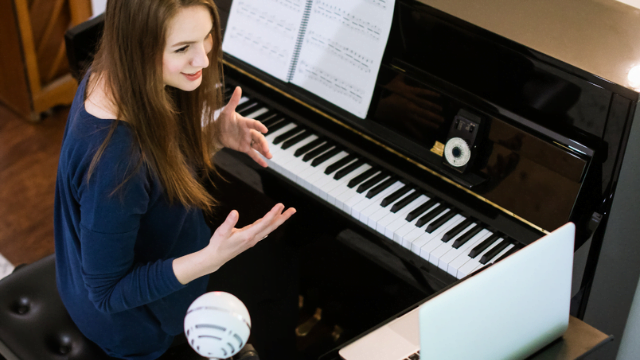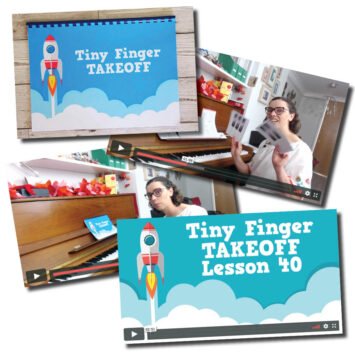
This blog post about teaching group piano lessons online was contributed by Joanna Shiel. Joanna is a London-based piano teacher, currently teaching exclusively online. She’s been successfully running a mix of group and solo piano lessons since the beginning of 2020, and loves the flexibility this mode of teaching offers. Joanna’s favourite dessert of the month is Baklava with extra honey.
You CAN teach group piano lessons online—yes, YOU. You can. And effectively, too. If you’ve ever considered adding this as an option to your studio, here’s your guide to getting started.

If you were anything like me, you probably assumed (and perhaps still do) that piano teaching is best done in person, in one-to-one lessons. But when the Covid-19 pandemic hit, you needed to keep your piano studio afloat and keep income rolling in. Who knew when you’d be able to open your doors to students again?
Fast forward to today: It looks like online lessons are here to stay. And if you’ve heard all the great benefits to teaching piano in a group setting, why not add a group lesson program to your virtual offerings, too?
Why Teaching Group Piano Lessons Online is Awesome
No single lesson configuration is going to be perfect. Whether you teach in person or online, there are always going to be pros and cons.
Here are some of the advantages from online group piano classes which I’ve found in my own teaching. Hopefully this will make things clearer for you if you decide to add online group piano lessons to your teaching program list.
Benefits to Teachers
- No commute time
- Less disruption to family/home life
- Potential to earn more per hour which can be reinvested back into your teaching business or into you personally, creating a more fulfilled and happy teacher
- Flexible teaching from wherever you have internet (I’ve taught group piano lessons online from Brazil, Bulgaria, USA, England, Portugal and Mexico)
- Low-cost setup
Benefits to Parents
- No commute time and no waiting around
- Parents are more likely to be involved in lessons, giving them more confidence to help their kid practice at home
- Online piano lessons can be recorded for review between lessons
Benefits to Students
- Students work on their performance skills every lesson
- It’s obvious when students don’t practice, which can be very motivating for some
- It’s easy to screen-share games and get the whole group involved in learning (see the VMT Library for a great selection of games with on-screen options)
- Students can see and hear the learning process of other students, absorbing corrections multiple times
- Less focus on individual students leads students to become more independent and wonderfully self-directed
- Community and friendships can form, possibly even with students from around the world
- They’ll have to have a good instrument at home, which sets them up for excellent long-term learning
Getting Started: Choices to Make
If you’re just now establishing group lessons as an option in your music teaching studio, there are a few choices you’ll need to make up front.
Choosing the Right Platform
Here are my go-to platforms for teaching group piano lessons online.
Zoom
Zoom is currently my platform of choice. I can screen-share games, record lessons and set up breakout rooms where my students can work on projects individually or in smaller groups. Teachers and students can also adapt their sound settings so things like compression don’t happen.
Skype
Skype is free and works well for groups. It has much of the same functionality as Zoom. However, there is no option for breakout rooms.
Rock Out Loud Live
Developed by a music school, Rock Out Loud Live is a platform made exclusively with music teachers in mind. Technical support for this platform is incredible – if you have any questions or need a walkthrough, Rock Out Loud will happily provide it.

With Rock Out Loud Live, sound is prioritised over video function which provides a great music learning experience.
Choosing the Skill Level of Students
Much of what applies to in-person group piano teaching can be applied to online lessons.
In my studio, I’ve taught groups with both simultaneous-levelled students and multi-levelled students. I think it’s a very personal choice, and you should choose the option which you think will suit your teaching style.
Multi-Levelled Groups
Multi-levelled groups are great for:
- Inspiring students: Those at a beginner level will love to watch more advanced students perform, inspiring young musicians and giving them something to strive for
- Teaching concepts at different levels: If you have a beginner student, they can learn concepts at their current skill level which can then be easily adapted into more difficult levels
- Teaching pieces at different levels: Where students learn at different paces, a piece can be levelled appropriately to challenge those at a greater skill level while still allowing beginners to learn and succeed (Melanie Bowes has a great example in this article of how to use a multi-levelled piece in group lessons)
- Mentorship opportunities: More advanced students are able to help beginner students and, in turn, help with their own learning process
Simultaneous-Levelled Groups
Simultaneous-levelled groups are great for:
- Healthy competition/accountability: When students see that others have practised during the week, this can demonstrate what is achievable and what is expected
- Benchmarking: Concepts can be taught in one go and tailored to each ability level of the student, giving them a benchmark of their ability and what is to come next
- Tailoring learning: Some students will grasp concepts or pieces more quickly than other students, teaching them that learning is non-linear and takes effort.
- Demonstrating: Pieces and concepts are often demonstrated in a variety of ways for different students, creating a lower-pressure environment for young students when compared to traditional one-on-one lessons
Mix and Match
You could certainly create a hybrid approach in your piano studio, mixing and matching what appeals to you or what works well for the students in your class. Or you could experiment with both options to see what truly works well for you and your students.
Group by Age
One thing which I do find helpful is grouping students by age and general ability (wherever possible.) I’ve found there are certain development milestones children pass which they need to be in a similar group for.
Choosing Creative Online Piano Group Curricula
Choosing the right methods and curricula when teaching online group piano classes is important, so take the time to get this right – it will be well worth it.
When choosing a curriculum, you might consider using:
- A method you’re already very familiar with
- Piano methods which are digitised or already designed for online lessons
- A group method
- Supplementary curricula such as Vibrant Music Teaching’s Powerbooster series or Tiny Finger Takeoff
When choosing, consider whether these would work well for simultaneous learning or a more multi-levelled approach. How could you adapt these curricula and methods to suit your desired online group outcome?
Vibrant Music Teaching is an amazing membership program for music studio teachers around the world. Not a member yet? Here’s what you’re missing!
Choosing Your Online Piano Lesson Group Size
Getting your group size right is a combination of what you find to be the right teaching balance for you and what you think is the optimal learning outcome. You might also find that the age range you tend to teach can have an effect.
Personally, I prefer to work with smaller group sizes and buddy lessons. My classes work well with a mix of 3-5 students or buddy lessons with a portion of solo lesson work and overlapping class time.
If a student wants to work on exam material, I offer that as an additional one-on-one lesson to their group lesson – maximising their time in lessons and highlighting the exam as the commitment it is.
Perhaps you’d like to experiment with larger online group sizes to see how they work for you.
Lesson Planning
It’s particularly important in group lessons that everyone ends up on the same page throughout the year, which makes lesson planning vital. The beauty is that once you’ve planned out your year’s curriculum, it becomes fairly easy to optimise it for various levels in your class.
Remember, you’ll have different abilities and levels in your class. So brainstorm ways in which you could teach the same concept to a beginner, an intermediate student and someone who is more advanced.
For more lesson planning resources, check out Nicola’s Planning Lessons hub page.
Structuring an Online Group Class
I always try to structure lessons around an interleaved approach – working on concepts in the piece while also practising and reviewing previously-learnt concepts.
Planning a rough outline of your lesson will give you a framework to work within, becoming invaluable to you each week.
Here’s a sample outline for a 60-minute simultaneous-levelled online group lesson which I like to follow in my lessons. It which implements a multi-levelled approach to learning 1 – 3 pieces a week focussed on conceptual learning.
| Time | Activity |
| 5 minutes | Performance opportunity |
| 5 minutes | Review previous week’s work |
| 5 minutes | Introduce today’s piece/work |
| 10 minutes | Group analysis of piece(s). Introduce key concepts. Group discussion on the best ways to approach learning goals. |
| 5 minutes | Game/activity break |
| 5 minutes | Practise/work on section of piece |
| 5 minutes | Game/activity break |
| 5 minutes | More practice |
| 5 minutes | Creative break (improvisation/group composition) |
| 5 minutes | More practice/performance opportunity |
| 5 minutes | Wrap up and share assignments for the week. Accountability. |
Feel free to use this structure as a starting point, then adjust as you become more experienced teaching group piano lessons online.
Wanna try a Google Slides game in your next online lesson? Enter your your info below and we’ll send you Key Kites, an online multi-level game where students of differing levels can play at the same time.

Subscribe to the newsletter and get the Key Kites Multi-level Screen Game
Enter your details to subscribe to the newsletter for piano teachers with information, tips and offers.
I hate spam as much as you do! I will only send you emails related directly to piano teaching and you can unsubscribe at any time.
Members of Vibrant Music Teaching can download both the printable and screen versions of Key Kites in the VMT Library. Not a member? You’re missing out on so much − including over 100 games you can play with your online students. Learn more about what you’ll get by being a member at vibrantmusicteaching.com.
Classroom Management
You’ll probably find your students quite comfortable with technology. It may even surprise you how naturally they take to online learning platforms.
Muting
Unless it’s a small group, I always ask students to mute themselves when practising and then unmute themselves when it’s their turn to play. Some students really love this control over when others can hear them.
Chatbox
This is another hidden advantage of having group lessons online. Students can message me to ask a question without the rest of the class knowing about it, or if I’m busy with another student.
It takes a bit of multitasking to manage chatbox requests, but I love the challenge.
Online Piano Group Workshops and Recitals
Perhaps you decide that you’d like to include workshops or a recital into your online group piano lesson program.
Congratulations!
This is a great idea, and totally doable.
Digital piano recitals are a popular option these days. In this video, you’ll discover are 3 great ways to run your own.
Teaching group workshops can also be fantastic for your online group piano classes. Did you know that we have many group lesson workshop plans in the VMT Library which are perfectly adaptable to online group lessons? I especially like the Dash Through the Past workshop plan and the Performance Party workshop plan.
Not a VMT member yet? Never heard of us, or still on the fence about joining? Check out the membership today!
Have I inspired you to add a group piano class to your online school?
Let me know in the comments below, I’d love to hear your thoughts.

